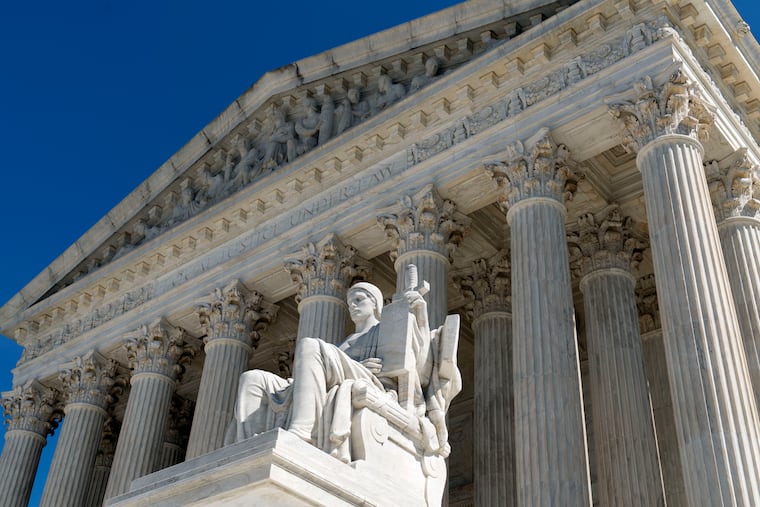8 issues to watch as the Supreme Court starts its new term
The docket suggests a continued trend of a motivated conservative majority considering high-profile, controversial topics including LGBTQ+ rights and voting access.

This week marks a new Supreme Court term and the first time Justice Ketanji Brown Jackson has taken the bench since her confirmation in April.
Last term, the Supreme Court issued several heavy-hitter rulings — including overturning Roe v. Wade, expanding gun rights, and endorsing religious liberties.
» READ MORE: Abortion views are dividing families and friend groups in the wake of Roe v. Wade being overturned
With a motivated conservative majority on the bench, the docket suggests that the controversies will continue into this term with issues like LGBTQ+ rights, voting access, and social media liability all appearing before the justices.
Here’s what you need to know:
The Supreme Court basics
The Supreme Court gathers from the first Monday of October through June or July before taking a summer recess. The court receives between 7,000 and 8,000 petitions each term and will end up hearing oral arguments for about 80 cases.
The court has nine justices — the chief justice and eight associate justices.
The current court has a six-justice supermajority of justices appointed by Republican presidents, whose rulings lean conservative. That lineup marks a court more divided than other times in recent history.
According to FiveThirtyEight, typically, about half of the court’s rulings are unanimous. But last term, SCOTUSBlog data revealed that 21% of the court’s rulings were split by party line of the president who appointed the justice. Only 29% of rulings were unanimous.
Cases to watch this term
This term is historical right off the bat with Jackson joining the ranks, the first time a Black woman has served on the court.
» READ MORE: Justice Ketanji Brown Jackson makes Supreme Court debut in brief ceremony
Specifics aren’t entirely nailed down yet, but the Supreme Court has already accepted a number of high-profile and controversial cases. Here’s a rundown:
Environmental protections
Case: Sackett v. Environmental Protection Agency.
What it’s about: A decision here could restrict the EPA’s enforcement of the Clean Water Act, the framework surrounding how water resources are regulated and protected. The case scrutinizes vague language within the law’s protections. Environmentalists say removing those protections could harm water supplies.
Oral arguments: Were Oct. 3.
Racial gerrymandering
Case: Merrill v. Milligan and Caster.
What it’s about: This case will decide if Alabama’s redistricting plan violated a section of the Voting Rights Act when a federal court called for a map that added a second congressional district favorable to a Black candidate. The court’s decision here could affect the future of racial gerrymandering nationwide.
Oral arguments: Were Oct. 4.
Animal cruelty
Case: National Producers Council v. Ross.
Animal cruelty: This case focuses on a California state law that aims to reduce animal cruelty against pigs bred for pork sales. The law bans the sale of pork unless the sows had 24 square feet of the space to roam freely. Critics mainly argue with the amount of space the law calls for — most pigs have significantly less space in their enclosures, making the rule difficult for pork suppliers in California.
Oral arguments: Oct. 11.
Affirmative action
Case: Students for Fair Admissions v. President and Fellows of Harvard College and University of North Carolina.
What it’s about: The Supreme Court will examine if universities are allowed to consider an applicant’s race in the admissions process while trying to build a diverse student body. Lower courts have said the schools in question had complied with the law and that the campuses were allowed to consider race as one factor within a larger scope of factors when looking at candidates. Critics say the court should overturn the established laws — which can ensure that underrepresented students of color are fairly considered — arguing the policies violate federal law that takes a “colorblind approach” to interpreting the Constitution.
Oral arguments: Oct. 31.
LGBTQ protections
Case: 303 Creative LLC v. Elenis.
What it’s about: This decision will surround LGBTQ protections against discrimination and how they may intersect with the First Amendment. The case asks whether a Colorado-based web designer could refuse to make same-sex wedding sites, citing her religious beliefs. A ruling here could suggest how the nine justices will approach other rulings surrounding LGBTQ rights.
Oral arguments: Not yet scheduled.
Immigration
Case: United States v. Texas.
What it’s about: This centers on an appeal from President Joe Biden’s administration following a Department of Homeland Security memo that told authorities only to target undocumented immigrants who threaten national security or public safety. It was part of an attempt to scale back the Trump administration’s approach. But the states of Texas and Louisiana sued, arguing that the new approach violated immigration law, and a federal District Court blocked the policy. The case could set precedent for how much control a presidential administration may have over immigration law.
Oral arguments: Not yet scheduled.
Elections and voting
Case: Moore v. Harper.
What it’s about: This case could affect legislative oversight on the administration of elections. It surrounds an election law case regarding how voting maps are drawn and how federal elections are held. North Carolina GOP lawmakers are appealing a ruling that found illegal gerrymandering within a voting map.
Oral arguments: Not yet scheduled.
Social media
Cases: Gonzalez v. Google, Twitter v. Taamneh.
Social media: The Supreme Court will hear two cases on social media culpability when it comes to terrorist content. One deals with a portion of the Communications Decency Act, which says social media platforms are normally protected from liability regarding user uploads. The case questions whether that statute applies when the platforms make “targeted recommendations” to their users. The second case centers on Twitter and how much action a social media platform should take to manage terrorism content circulating on it.
Oral arguments: Not yet scheduled.